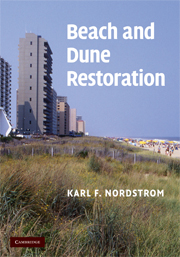Book contents
- Frontmatter
- Contents
- Preface
- Acknowledgments
- 1 The need for restoration
- 2 Beach nourishment and impacts
- 3 Dune building practices and impacts
- 4 Restoring processes, structure, and functions
- 5 Options in spatially restricted environments
- 6 A locally based program for beach and dune restoration
- 7 Stakeholder interests, conflicts, and co-operation
- 8 Research needs
- References
- Index
Preface
Published online by Cambridge University Press: 14 August 2009
- Frontmatter
- Contents
- Preface
- Acknowledgments
- 1 The need for restoration
- 2 Beach nourishment and impacts
- 3 Dune building practices and impacts
- 4 Restoring processes, structure, and functions
- 5 Options in spatially restricted environments
- 6 A locally based program for beach and dune restoration
- 7 Stakeholder interests, conflicts, and co-operation
- 8 Research needs
- References
- Index
Summary
This book is about restoring landforms and enhancing their functions and services on intensively developed coasts. It is a follow-up to my book Beaches and Dunes of Developed Coasts, which identified the many ways beaches and dunes are transformed by human actions and the differences between natural landforms and the human artifacts that replace them. In writing that book, it became obvious that many transformations of the coastal landscape, even those involving construction of new landforms, were being done with little thought given both to the accompanying environmental losses and the potential opportunities for achieving new environmental gains. Traditional beach and dune building practices emphasize the use of landforms for protection and recreation, but that does not preclude adding new natural resource values compatible with those uses. In many cases, the modification of traditional shore protection projects to achieve nature goals can be accomplished with little change in design or cost. I acknowledge that human-use functions will be the driving forces for managing beaches in developed areas, so a return to a condition of pristine nature is not an option. Restored landforms and habitats will be subject to direct human use or indirect effects resulting from land uses in adjacent areas, and these landforms may require periodic human adjustments to survive. The impossibility of returning to pristine nature should not deter efforts to regain elements of the natural environment and reverse the trend toward environmental loss.
- Type
- Chapter
- Information
- Beach and Dune Restoration , pp. ix - xPublisher: Cambridge University PressPrint publication year: 2008

